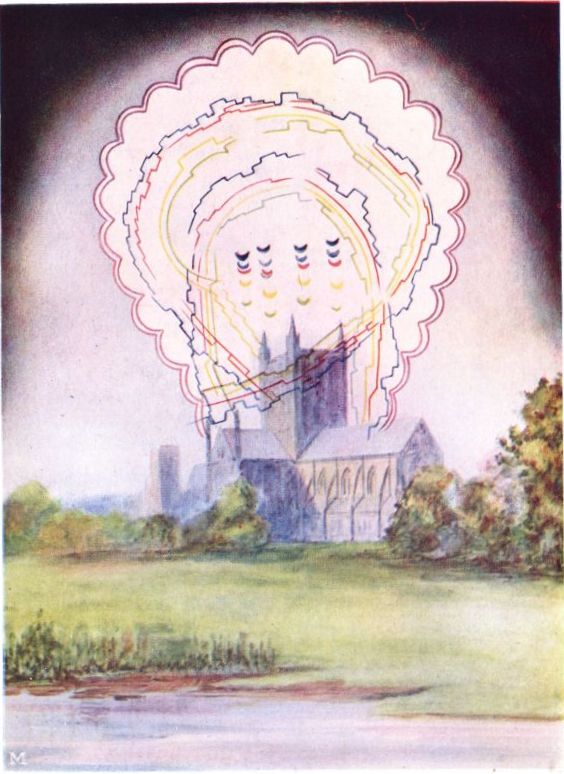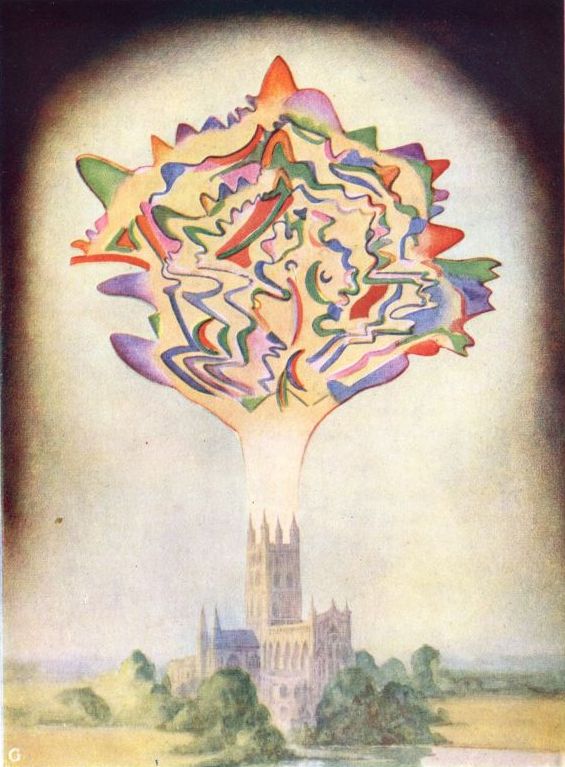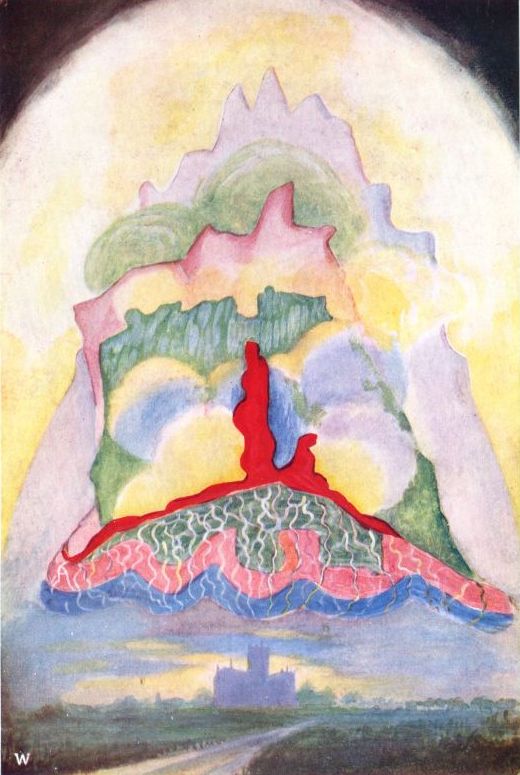FORMS BUILT BY MUSIC
Before closing this little treatise it will perhaps be of interest to our readers to give a few examples of another type of forms unknown to those who are confined to the physical senses as their means of obtaining information. Many people are aware that sound is always associated with colour—that when, for example, a musical note is sounded, a flash of colour corresponding to it may be seen by those whose finer senses are already to some extent developed. It seems not to be so generally known that sound produces form as well as colour, and that every piece of music leaves behind it an impression of this nature, which persists for some considerable time, and is clearly visible and intelligible to those who have eyes to see. Such a shape is perhaps not technically a thought-form—unless indeed we take it, as we well may, as the result of the thought of the composer expressed by means of the skill of the musician through his instrument.
Some such forms are very striking and impressive, and naturally their variety is infinite. Each class of music has its own type of form, and the style of the composer shows as clearly in the form which his music builds as a man's character shows in his handwriting. Other possibilities of variation are introduced by the kind of instrument upon which the music is performed, and also by the merits of the player. The same piece of music if accurately played will always build the same form, but that form will be enormously larger when it is played upon a church organ or by a military band than when it is performed upon a piano, and not only the size but also the texture of the resultant form will be very different. There will also be a similar difference in texture between the result of a piece of music played upon a violin and the same piece executed upon the flute. Again, the excellence of the performance has its effect, and there is a wonderful difference between the radiant beauty of the form produced by the work of a true artist, perfect alike in expression and execution, and the comparatively dull and undistinguished-looking one which represents the effort of the wooden and mechanical player. Anything like inaccuracy in rendering naturally leaves a corresponding defect in the form, so that the exact character of the performance shows itself just as clearly to the clairvoyant spectator as it does to the auditor.
It is obvious that, if time and capacity permitted, hundreds of volumes might be filled with drawings of the forms built by different pieces of music under different conditions, so that the most that can be done within any reasonable compass is to give a few examples of the leading types. It has been decided for the purposes of this book to limit these to three, to take types of music presenting readily recognisable contrasts, and for the sake of simplicity in comparison to present them all as they appeared when played upon the same instrument—a very fine church organ. In each of our Plates the church shows as well as the thought-form which towers far into the air above it; and it should be remembered that though the drawings are on very different scales the church is the same in all three cases, and consequently the relative size of the sound-form can easily be calculated. The actual height of the tower of the church is just under a hundred feet, so it will be seen that the sound-form produced by a powerful organ is enormous in size.
Such forms remain as coherent erections for some considerable time—an hour or two at least; and during all that time they are radiating forth their characteristic vibrations in every direction, just as our thought-forms do; and if the music be good, the effect of those vibrations cannot but be uplifting to every man upon whose vehicles they play. Thus the community owes a very real debt of gratitude to the musician who pours forth such helpful influences, for he may affect for good hundreds whom he never saw and will never know upon the physical plane.
Mendelssohn.—The first of such forms, a comparatively small and simple one, is drawn for us in Plate M. It will be seen that we have here a shape roughly representing that of a balloon, having a scalloped outline consisting of a double violet line. Within that there is an arrangement of variously-coloured lines moving almost parallel with this outline; and then another somewhat similar arrangement which seems to cross and interpenetrate the first. Both of these sets of lines evidently start from the organ within the church, and consequently pass upward through its roof in their course, physical matter being clearly no obstacle to their formation. In the hollow centre of the form float a number of small crescents arranged apparently in four vertical lines.
 PLATE M. MUSIC OF MENDELSSOHN
PLATE M. MUSIC OF MENDELSSOHN
Let us endeavour now to give some clue to the meaning of all this, which may well seem so bewildering to the novice, and to explain in some measure how it comes into existence. It must be recollected that this is a melody of simple character played once through, and that consequently we can analyse the form in a way that would be quite impossible with a larger and more complicated specimen. Yet even in this case we cannot give all the details, as will presently be seen. Disregarding for the moment the scalloped border, we have next within it an arrangement of four lines of different colours running in the same direction, the outermost being blue and the others crimson, yellow, and green respectively. These lines are exceedingly irregular and crooked; in fact, they each consist of a number of short lines at various levels joined together perpendicularly. It seems that each of these short lines represents a note of music, and that the irregularity of their arrangement indicates the succession of these notes; so that each of these crooked lines signifies the movement of one of the parts of the melody, the four moving approximately together denoting the treble, alto, tenor and bass respectively, though they do not necessarily appear in that order in this astral form. Here it is necessary to interpolate a still further explanation. Even with a melody so comparatively simple as this there are tints and shades far too finely modulated to be reproduced on any scale at all within our reach; therefore it must be said that each of the short lines expressing a note has a colour of its own, so that although as a whole that outer line gives an impression of blueness, and the one next within it of carmine, each yet varies in every inch of its length; so that what is shown is not a correct reproduction of every tint, but only the general impression.
The two sets of four lines which seem to cross one another are caused by two sections of the melody; the scalloped edging surrounding the whole is the result of various flourishes and arpeggios, and the floating crescents in the centre represent isolated or staccato chords. Naturally the arpeggios are not wholly violet, for each loop has a different hue, but on the whole they approach more nearly to that colour than to any other. The height of this form above the tower of the church is probably a little over a hundred feet; but since it also extends downwards through the roof of the church its total perpendicular diameter may well be about a hundred and fifty feet. It is produced by one of Mendelssohn's "Lieder ohne Wörte," and is characteristic of the delicate filigree-work which so often appears as the result of his compositions.
The whole form is seen projected against a coruscating background of many colours, which is in reality a cloud surrounding it upon every side, caused by the vibrations which are pouring out from it in all directions.
Gounod.—In Plate G we have an entirely different piece—a ringing chorus by Gounod. Since the church in the illustration is the same, it is easy to calculate that in this case the highest point of the form must rise fully six hundred feet above the tower, though the perpendicular diameter of the form is somewhat less than that, for the organist has evidently finished some minutes ago, and the perfected shape floats high in the air, clearly defined and roughly spherical, though rather an oblate spheroid. This spheroid is hollow, as are all such forms, for it is slowly increasing in size—gradually radiating outward from its centre, but growing proportionately less vivid and more ethereal in appearance as it does so, until at last it loses coherence and fades away much as a wreath of smoke might do. The golden glory surrounding and interpenetrating it indicates as before the radiation of its vibrations, which in this case show the dominant yellow in much greater proportion than did Mendelssohn's gentler music.

PLATE G. MUSIC OF GOUNOD
The colouring here is far more brilliant and massive than in Plate M, for this music is not so much a thread of murmurous melody as a splendid succession of crashing chords. The artist has sought to give the effect of the chords rather than that of the separate notes, the latter being scarcely possible on a scale so small as this. It is therefore more difficult here to follow the development of the form, for in this much longer piece the lines have crossed and intermingled, until we have little but the gorgeous general effect which the composer must have intended us to feel—and to see, if we were able to see. Nevertheless it is possible to discern something of the process which builds the form, and the easiest point at which to commence is the lowest on the left hand as one examines the Plate. The large violet protrusion there is evidently the opening chord of a phrase, and if we follow the outer line of the form upward and round the circumference we may obtain some idea of the character of that phrase. A close inspection will reveal two other lines further in which run roughly parallel to this outer one, and show similar successions of colour on a smaller scale, and these may well indicate a softer repetition of the same phrase.
Careful analysis of this nature will soon convince us that there is a very real order in this seeming chaos, and we shall come to see that if it were possible to make a reproduction of this glowing glory that should be accurate down to the smallest detail, it would also be possible patiently to disentangle it to the uttermost, and to assign every lovely touch of coruscating colour to the very note that called it into existence. It must not be forgotten that very far less detail is given in this illustration than in Plate M; for example, each of these points or projections has within it as integral parts, at least the four lines or bands of varying colour which were shown as separate in Plate M, but here they are blended into one shade, and only the general effect of the chord is given. In M we combined horizontally, and tried to show, the characteristics of a number of successive notes blended into one, but to keep distinct the effect of the four simultaneous parts by using a differently-coloured line for each. In G we attempt exactly the reverse, for we combine vertically, and blend, not the successive notes of one part, but the chords, each probably containing six or eight notes. The true appearance combines these two effects with an inexpressible wealth of detail.
Wagner.—No one who has devoted any study to these musical forms would hesitate in ascribing the marvellous mountain-range depicted in Plate W to the genius of Richard Wagner, for no other composer has yet built sound edifices with such power and decision. In this case we have a vast bell-shaped erection, fully nine hundred feet in height, and but little less in diameter at the bottom, floating in the air above the church out of which it has arisen. It is hollow, like Gounod's form, but, unlike that, it is open at the bottom. The resemblance to the successively retreating ramparts of a mountain is almost perfect, and it is heightened by the billowy masses of cloud which roll between the crags and give the effect of perspective. No attempt has been made in this drawing to show the effect of single notes or single chords; each range of mimic rocks represents in size, shape, and colour only the general effect of one of the sections of the piece of music as seen from a distance. But it must be understood that in reality both this and the form given in Plate G are as full of minute details as that depicted in Plate M, and that all these magnificent masses of colour are built up of many comparatively small bands which would not be separately visible upon the scale on which this is drawn. The broad result is that each mountain-peak has its own brilliant hue, just as it is seen in the illustration—a splendid splash of vivid colour, glowing with the glory of its own living light, spreading its resplendent radiance over all the country round. Yet in each of these masses of colour other colours are constantly flickering, as they do over the surface of molten metal, so that the coruscations and scintillations of these wondrous astral edifices are far beyond the power of any physical words to describe.
 PLATE W. MUSIC OF WAGNER
PLATE W. MUSIC OF WAGNER
A striking feature in this form is the radical difference between the two types of music which occur in it, one producing the angular rocky masses, and the other the rounded billowy clouds which lie between them. Other
motifs are shown by the broad bands of blue and rose and green which appear at the base of the bell, and the meandering lines of white and yellow which quiver across them are probably produced by a rippling arpeggio accompaniment.
In these three Plates only the form created directly by the sound-vibrations has been drawn, though as seen by the clairvoyant it is usually surrounded by many other minor forms, the result of the personal feelings of the performer or of the emotions aroused among the audience by the music. To recapitulate briefly: in Plate M we have a small and comparatively simple form pourtrayed in considerable detail, something of the effect of each note being given; in Plate G we have a more elaborate form of very different character delineated with less detail, since no attempt is made to render the separate notes, but only to show how each chord expresses itself in form and colour; in Plate W we have a still greater and richer form, in the depiction of which all detail is avoided, in order that the full effect of the piece as a whole may be approximately given.
Naturally every sound makes its impression upon astral and mental matter—not only those ordered successions of sounds which we call music. Some day, perhaps, the forms built by those other less euphonious sounds may be pictured for us, though they are beyond the scope of this treatise; meantime, those who feel an interest in them may read an account of them in the little book on
The Hidden Side of Things.
[1]
It is well for us ever to bear in mind that there is a hidden side to life—that each act and word and thought has its consequence in the unseen world which is always so near to us, and that usually these unseen results are of infinitely greater importance than those which are visible to all upon the physical plane. The wise man, knowing this, orders his life accordingly, and takes account of the whole of the world in which he lives, and not of the outer husk of it only. Thus he saves himself an infinity of trouble, and makes his life not only happier but far more useful to his fellow-men. But to do this implies knowledge—that knowledge which is power; and in our Western world such knowledge is practically obtainable only through the literature of Theosophy.
To exist is not enough; we desire to live intelligently. But to live we must know, and to know we must study; and here is a vast field open before us, if we will only enter upon it and gather thence the fruits of enlightenment. Let us, then, waste no more time in the dark dungeons of ignorance, but come forth boldly into the glorious sunshine of that divine wisdom which in these modern days men call Theosophy.

















